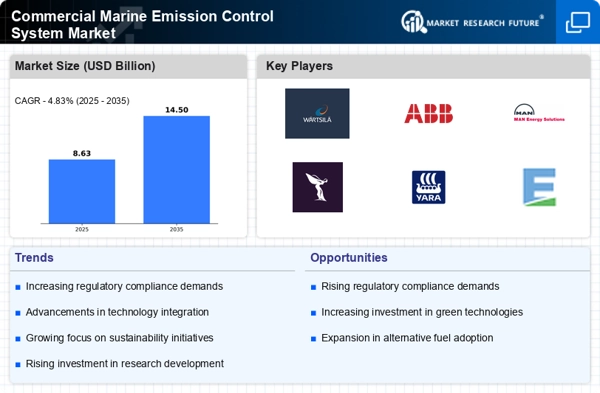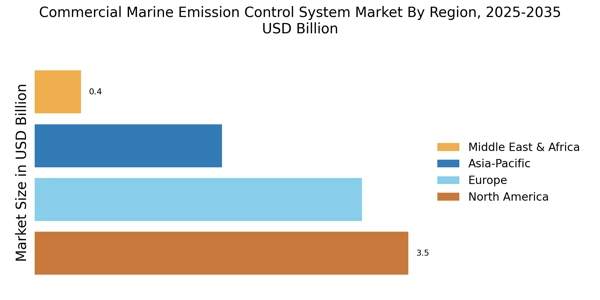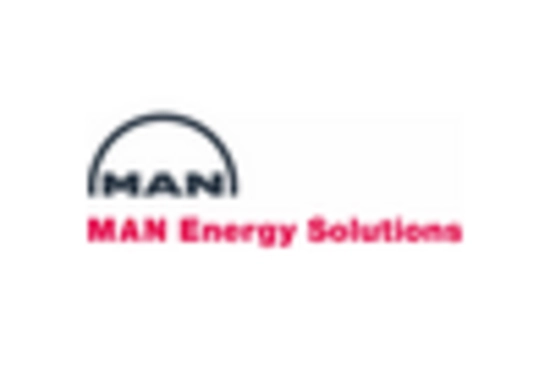Increasing Environmental Regulations
The Commercial Marine Emission Control System Market is experiencing a surge in demand due to the tightening of environmental regulations. Governments and international bodies are implementing stricter emission standards to combat air pollution and climate change. For instance, the International Maritime Organization has set ambitious targets to reduce greenhouse gas emissions from shipping by at least 50% by 2050. This regulatory landscape compels shipping companies to invest in advanced emission control systems to ensure compliance. As a result, the market for these systems is projected to grow significantly, with estimates suggesting a compound annual growth rate of over 10% in the coming years. Companies that proactively adopt these technologies may gain a competitive edge, positioning themselves as environmentally responsible entities in the maritime sector.
Rising Fuel Prices and Operational Costs
The Commercial Marine Emission Control System Market is also being driven by the rising fuel prices and operational costs associated with maritime transportation. As fuel prices continue to fluctuate, shipping companies are seeking ways to optimize fuel consumption and reduce emissions simultaneously. Emission control systems, such as scrubbers and catalytic converters, can enhance fuel efficiency while ensuring compliance with environmental regulations. This dual benefit is particularly appealing in a market where operational costs are under constant scrutiny. Furthermore, the implementation of these systems can lead to long-term savings, as they help mitigate the financial impact of rising fuel prices. Consequently, the demand for effective emission control solutions is expected to grow, as companies strive to balance cost management with environmental responsibility.
Economic Incentives and Funding Opportunities
Economic incentives and funding opportunities are emerging as significant drivers in the Commercial Marine Emission Control System Market. Various governments are offering financial support and subsidies to encourage the adoption of emission control technologies. These incentives can significantly reduce the initial investment burden for shipping companies, making it more feasible to implement advanced systems. Additionally, international financial institutions are increasingly providing funding for projects aimed at reducing emissions in the maritime sector. This financial backing is likely to accelerate the adoption of emission control systems, as companies can leverage these resources to enhance their operational capabilities while adhering to environmental standards. The availability of such funding options may lead to a more rapid transformation within the industry.
Technological Innovations in Emission Control
Technological advancements are playing a pivotal role in shaping the Commercial Marine Emission Control System Market. Innovations such as scrubbers, selective catalytic reduction systems, and advanced monitoring technologies are enhancing the efficiency of emission control. These technologies not only help in meeting regulatory requirements but also improve operational efficiency. For example, the integration of real-time monitoring systems allows for better management of emissions, leading to reduced operational costs. The market is witnessing a shift towards more sophisticated solutions that can adapt to varying fuel types and operational conditions. As a result, companies investing in research and development are likely to capture a larger share of the market, as they offer cutting-edge solutions that address both compliance and performance.
Growing Demand for Sustainable Shipping Practices
The Commercial Marine Emission Control System Market is increasingly influenced by the rising demand for sustainable shipping practices. Stakeholders, including consumers and investors, are becoming more environmentally conscious, prompting shipping companies to adopt greener technologies. This shift is evident in the growing preference for vessels equipped with emission control systems that minimize environmental impact. According to recent studies, nearly 70% of consumers are willing to pay a premium for products shipped via environmentally friendly methods. Consequently, shipping companies are investing in emission control technologies to enhance their sustainability profiles. This trend not only aligns with regulatory requirements but also caters to market demand, potentially leading to increased profitability for companies that prioritize sustainability.


















Leave a Comment